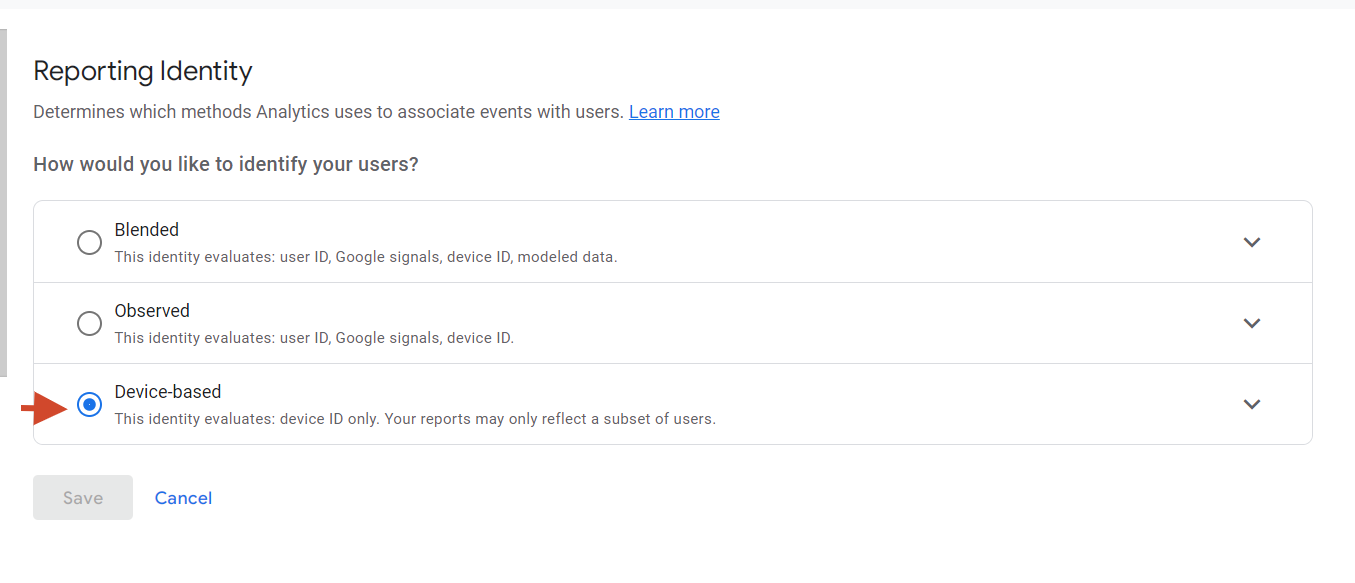Plenty has been said and written about Google Analytics 4 (GA4), but one overlooked message is one about expectations.
Marketers used to the legacy Google Analytics Universal platform for most of the past decade need to adjust. Their lives would be easier if the right expectations were set.
I recently had the privilege of discussing this very thing with three GA4 professionals who were kind enough to give me their insights.
Below are some of the most significant expectations as GA4 becomes your primary measurement platform.
1. GA4 Is Not Plug & Play Like GA Universal
To be fair, Universal was never completely “plug and play.”
There’s some setup (goal conversions, events, filters, enhanced ecommerce tracking, etc.), but nothing like GA4 is.
The planning and setup can take way more time than Universal.
Analytics professional Alan K’necht from K’nechtology said:
“Google followed the 80-20 rule. They saw that 80% of their users were only using 20% of their reports and scrapped the other 80%. ‘Sorry’ if that was one that people were using. You now need to create a custom report.”
2. Everything’s An Event (So Get Used To It)
In GA Universal, an average site may have five to 15 site actions set up to count as an “event” (completed video views, gallery views, ungated download, etc.).
In GA4, everything is an event, and you might as well get used to it.
- Pageview = Event.
- Session Start = Event.
- First Visit = Event.
- Scroll = Event.
- Click = Event.
- Video Start = Event.
- File Download = Event.
- Video progression = Event.
- Video complete = Event.
- Newsletter Signup = Event.
- Contact Submission = Event.
- View Search Results = Event.
- You get the idea. Everything remotely worth measuring is an event.
3. Don’t Expect A Reliable Apples To Apples Comparison Of Year Over Year (YoY) Data
Remember when using Universal for one year and GA4 for the next.
If you have both platforms (GA Universal & GA4) running side-by-side today, you’ll notice the numbers don’t match.
One of the reasons there was a huge push to get everyone on GA4 and tracking data by July 1, 2022, is so marketers can have YOY numbers in July 2023, because there would be a full year of data being measured similarly.
Anna Slyter, Head of Analytics for NordicClick Interactive, advised:
“To be clear, marketers should never rely on Google Analytics for exact numbers – it’s meant to measure trends – Universal was that way, and so is GA4.”
(Disclosure: The author is also employed by NordicClick Interactive.)
It’s also not a surprise the numbers from GA4 won’t match what you see in Universal.
K’necht added, “There has never been a 1-to-1 ratio of analytics data between products. Each one uses various algorithms and calculations. History is repeating itself.”
4. You Can Do A Lot More With GA4 (Than Universal), But There’s A Catch
Simply put, the catch is that it’s a lot more complicated.
For example, it’s:
- More complicated to set up and validate tracking.
- More complicated to create basic reports.
- More complicated to manage.
- More complicated to use.
K’necht said:
“Google has moved their analytics product from something easy to use by everyone but with limitations to a product that is more tailored to analytics professionals where it offers far more customization and flexibility.
However, sadly, this takes its use out of the hands of most small businesses who wanted to do the analytics themselves.”
5. Annotations Are Missing From The GA4 Interface
Annotations are one of Universal’s most useful and beloved features – for a good reason. Within the platform, you can document an abnormality (spike or decline), so it’s easy to recall it long after it occurs.
For now, it will be very important to keep a separate list to document annotations until Google gets that feature added back in (to GA4).
Of course, this could get added back in at any point, but as of this publication, it hasn’t been.
6. Small Website? Welcome To The World Of “Thresholding”
If you have a small amount of data and try running a report for a narrow time range, you’re likely to run into “thresholding.”
Simply put, Google doesn’t want you to be able to identify an individual via GA4 personally.
For example, if you have a small ecommerce site that gets less than ten orders per day, you would likely be able to identify an individual user by taking their order and looking at what time they were on your site, where they went, what was in the cart, etc.
Slyter explained:
“Thresholding in GA4 (when Google Signals is on) is a massive pain for ‘standard’ reports.
Custom explorations appear to show the data better. Still, that data will only be available for up to 14 months (depending on data retention settings) – so, a data warehouse would be useful to retain data longer.”
Editor’s note: One can still avoid thresholding by selecting “Device based” Reporting Identity with the screenshot below. In most cases, that option works just great, and if you don’t have a user login on your web app, device based is the best option to go.
 Screenshot by editor, October 2022
Screenshot by editor, October 20227. There Will Be Less Free Stuff From Google
The previous point mentioned a 14-month availability limit on data, so it’s clear they don’t wish to provide free data storage indefinitely.
Knecht added:
“Hence the maximum of 14 months of live interactive data. Instead (of storing it indefinitely) they gave us a free (but smaller version of the paid) instance of BigQuery. Here you can keep your data until it is full.
For most businesses, this will be several years’ worth of data, but if you need more space, you can upgrade to the paid version.”
Editor’s note: Also, you can’t create multiple filtered views – it is now a paid feature.
8. Bounce Rate Is Now Available, But That Doesn’t Mean You Should Pay Attention To It
Initially, it wasn’t a part of GA4, but apparently, enough feedback convinced Google of its need to be included.
It is back but measured very differently than it is in Universal. It is 100% minus the new “Engagement Rate” metric.
For example, if you have a 76% engagement rate, you now have a 24% bounce rate.
K’necht said:
“I’ve been warning my clients for over five years that bounce rate shouldn’t be a KPI – that taken out of context, it is a meaningless number.
I was happy when Google removed it from GA4. But they heard the complaints and put in something and called it ‘Bounce Rate.'”
9. Become Friends With BigQuery & SQL (Or At Least Be A Friend Of A Friend)
Suppose your site is subjected to data sampling (even if it’s not), and you want increased flexibility regarding report building and analysis. In that case, you must get familiar with BigQuery and SQL.
While this is beyond the need or ability of most small to medium small businesses, larger businesses will now be able to leverage BigQuery and bring data from other sources (contact management software, for example) and combine the data to get a whole picture instead of just a window into the web-only aspect of Universal Analytics.
Inigo Belosio (also from NordicClick), who’s performed his share of GA4 implementations this last year, said, “The good news is that GA4 connects to BigQuery natively and for free – unlike UA – and SQL is a relatively easy programming language to learn.”
Belosio added, “Unfortunately, most of these concepts are unknown to most marketers, so I highly encourage you to get familiar with them as your ability to squeeze GA4’s potential may depend on it as your site grows.”
K’necht concluded, “Using BigQuery will also allow segmentation over larger amounts of data without the issue of data sampling that happens when using UA or GA4 on its own, and fortunately, there are tools like Google’s DataStudio which can be used to simplify this effort in the creation of various reports and dashboards.”
10. You’ll Need To Level Up On Your Analyst Skills (Or Bring In A Resource Who’s Already There)
K’necht said, “Ultimately, Google has aligned their analytics product more closely with Adobe Analytics, a tool that is not for the faint of heart or untrained user.”
He added, “If you plan on continuing to use Google Analytics (GA4), it’s time to either take a course in GA4 configuration & management or engage a resource to handle it for you.”
Editor’s note: Google Data Studio connector is already available and really helps to make analyzing data easy. So one can learn GDS to compose beautiful reports from analytics data.
11. Get To Know Your New Friend: Data Modeling
Data modeling in GA4 is finally here and has the potential to help fill the data loss gaps of those sites most impacted by users opting out of any cookies.
While some basic requirements exist to qualify, websites (especially those subjected to GDPR [General Data Protection Regulation] and other privacy regulations) will want to start testing this modeling feature.
Bellosio explained, “For example, it may be able to account for user traffic drops which, in some cases, can be very noticeable as we have already seen with several clients impacted by regulations and browser and operating system privacy updates (for example, iOS).”
12. Last – Set The Proper Expectations With Your Stakeholders
Many of the metrics your stakeholders may have been used to with Universal will change once you begin using GA4.
Make sure you set their expectations of:
- What changed.
- Why it has changed.
- What metrics they should be paying attention to.
- What they’ve gained with this new view of their web analytics.
I hope this was helpful.
GA4 will continue to evolve, so make sure you stay on top of it all!
More resources:
- Should You Switch To GA4 Now? What You Need To Know
- Getting Started With GA4: These 4 Tips Will Get You Up & Running
- Learn GA4: 17 Top Guides & Educational Resources
Featured Image: metamorworks/Shutterstock





